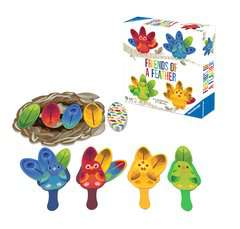Nagaraja is the latest two-player game from Hurrican, the boutique publisher in the Asmodee family that produced the two-player dice-rolling game Kero. Co-designed by Bruno Cathala (Kingdomino, Five Tribes), Nagaraja combines tile-laying and dice-rolling in a game of medium complexity that seemed like it had one rule too many for a game that doesn’t allow for a ton of deep planning – but it might fit for players who want something slightly heavier in their two-player games.
Players in Nagaraja each start with a blank 3×3 board that has nine relic tiles randomly distributed face-down around three sides, with the fourth side, facing the player, providing three entrances for the player to start building paths to the relics. On each turn, the players will play cards to bid for a tile, revealed at the start of the turn, that they’ll be able to place on their boards. The tiles all show different configurations of paths, and once a player has completed a path from an entrance to any relic tile, they flip that tile over and gain anywhere from 3 to 6 points. The first player to rack up 25 points wins the game, but your 6-point relic tiles are cursed, and if you reveal three of them you automatically lose the game.
The cards and the dice are really the essence of the game, though, as just acquiring enough tiles will eventually get you the relic points you want. The cards have two parts; the top part shows some combination of the game’s dice, while the bottom shows some kind of game function like letting you rotate a tile you’ve already placed, giving you additional cards, or adding ‘fate points’ to your dice roll that turn. You choose one or more cards for their dice symbols on each turn, which means you won’t use the benefits on the bottom of those cards, and then roll the dice, which are called ‘fate sticks,’ four-sided rectangular prisms in three different colors. All dice have different numbers of fate points on some sides; the brown dice have the most, but don’t have any of the other symbols, ‘nagas,’ that give you the right to play cards, while the white and green dice do. After your roll, if you have any nagas showing, you may play one card per naga. Once both players have passed, they compare all of their fate points showing on dice and cards they’ve played; the tile goes to the player with the most fate points, and to the start player if there’s a tie.
There are two card functions that seem especially valuable, to the point that you’d probably never want to play them for their dice unless you have no choice. One type lets you peek at one or two relics – yours or your opponent’s – which is almost solely about figuring out where the cursed ones are. You can use other cards to switch relics, including your opponent’s, so in theory you could switch your opponent’s to make them lose the gamer. (You can’t swap one of your relics for one of your opponent’s, however.) The other type that seems especially valuable lets you gain two cards, it’s valuable because you don’t automatically replenish your hand each turn. The player who doesn’t win the tile in a round draws three cards, keeping two and handing the other player the third. Thus it doesn’t take very long to run short of cards, and a big part of your strategy has to involve gaining cards.
Nagaraja also has some take-that cards in the game, including one unique card that lets you place a separate tile with no paths on your opponent’s board, and cards that let you move or rotate your opponents’ tiles. It seems like those cards are useful if you really fall behind, but if you’re close it’ll probably be more productive to try to build out your own board, especially once you know where your 6-point relics are.
Some tiles have spaces for amulet tokens, which can be worth 1 or 2 points, let you draw extra cards (the most valuable), or let you cancel the effect of a card your opponent has just played. This felt like the one game feature that was a rule too many, just one feature that the game didn’t need and that added more pieces to manage on the table without a huge benefit. Those functions could have been on cards, for example, although the amulets are kept secret from your opponent. You’re managing cards, rolling dice, placing tiles, creating paths on your board (and maybe rerouting them to get to different relics), and also have a couple of amulets. Somehow it all added up to one game element too many – but there’s also a strong balance here of strategy and randomness, and the game is fairly well balanced for two players, with the potential for high interaction between them. It’s a solid game that didn’t speak to me, one I can see is objectively good but probably won’t play that much myself given the other two-player options I have in the house.






